Acescores
On this page, you find all documents, package deals, and flashcards offered by seller acescores.
- 53
- 0
- 0
Community
- Followers
- Following
53 items
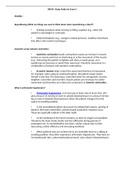
Exam of 10 pages for the course NR224 Study Guide at NR224 Study Guide exam 2 (NR224 Study Guide)
Mobility – Repositioning (What are things you need to think about when repositioning a client?) • Seeking assistance when moving or lifting a patient (e.g., when the patient is overweight or confused). • Patient limitations (e.g., changes in blood pressure, mobility restrictions) that affect safe transfer techniques Isometric verses isotonic contraction: • Isometric contraction (static contraction) causes an increase in muscle tension or muscle work but no shortening or active move...
- Exam (elaborations)
- • 10 pages •
Mobility – Repositioning (What are things you need to think about when repositioning a client?) • Seeking assistance when moving or lifting a patient (e.g., when the patient is overweight or confused). • Patient limitations (e.g., changes in blood pressure, mobility restrictions) that affect safe transfer techniques Isometric verses isotonic contraction: • Isometric contraction (static contraction) causes an increase in muscle tension or muscle work but no shortening or active move...

Exam (elaborations) NUTRITION C787Units 1-3. Already graded A+ NUTRITION C787Units 1-3.
“Readings” link to course reading materials Unit 2: Nutrition to Support Wellness (Cohort 1) Reading: Macronutrients -Identify the differences between macronutrients and micronutrients Macronutrients include carbs, lipids, and proteins d/t consumed in largest quantities. Include Ca, NaCl, Mg, K, Ph, and S. Micronutrients are vitamins and minerals that are required in small amounts. Include copper, I, Fe, Zinc. -Differentiate the S/S for the following diseases: obesity, marasmus, kwash...
- Exam (elaborations)
- • 8 pages •
“Readings” link to course reading materials Unit 2: Nutrition to Support Wellness (Cohort 1) Reading: Macronutrients -Identify the differences between macronutrients and micronutrients Macronutrients include carbs, lipids, and proteins d/t consumed in largest quantities. Include Ca, NaCl, Mg, K, Ph, and S. Micronutrients are vitamins and minerals that are required in small amounts. Include copper, I, Fe, Zinc. -Differentiate the S/S for the following diseases: obesity, marasmus, kwash...
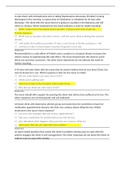
Exam (elaborations) HESI PRACTICE TEST 75 PREGUNTAS 2020 HESI PRACTICE TEST 75 PREGUNTAS 2020
A male client with schizophrenia who is taking fluphenazine decanoate (Prolixin) is being discharged in the morning. A repeat dose of medication is scheduled for 20 days after discharge. The client tells the nurse that he is going on vacation in the Bahamas and will return in 18 days. Which statement by the client indicates a need for health teaching? When I return from my tropical island vacation, I will go to the clinic to get my Prolixin injection. While I am on vacation and when I return...
- Exam (elaborations)
- • 24 pages •
A male client with schizophrenia who is taking fluphenazine decanoate (Prolixin) is being discharged in the morning. A repeat dose of medication is scheduled for 20 days after discharge. The client tells the nurse that he is going on vacation in the Bahamas and will return in 18 days. Which statement by the client indicates a need for health teaching? When I return from my tropical island vacation, I will go to the clinic to get my Prolixin injection. While I am on vacation and when I return...
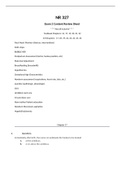
NR327 - Quiz 4 - Postpartum NCLEX-Style Questions (For Quiz 4) NR327 - Quiz 4 - Postpartum NCLEX-Style Questions (For Quiz 4)
NR327 - Quiz 4 - Postpartum NCLEX-Style Questions (For Quiz 4) - July 2019 Source Of Questions For This Quiz: Saunders Comprehensive Review - NCLEX-RN Exam Topics For This Quiz: Postpartum Physiologic Adaptations Postpartum Psychosocial Adaptations Postpartum Complications Assessment of the Normal Newborn Care of the Normal Newborn Postpartum NCLEX Material: Newborn NCLEX Material in Quizlets: 1. 2. Postpartum Physiological/Psychosocial Adaptations & Postpartum Complications NCLEX...
- Exam (elaborations)
- • 45 pages •
NR327 - Quiz 4 - Postpartum NCLEX-Style Questions (For Quiz 4) - July 2019 Source Of Questions For This Quiz: Saunders Comprehensive Review - NCLEX-RN Exam Topics For This Quiz: Postpartum Physiologic Adaptations Postpartum Psychosocial Adaptations Postpartum Complications Assessment of the Normal Newborn Care of the Normal Newborn Postpartum NCLEX Material: Newborn NCLEX Material in Quizlets: 1. 2. Postpartum Physiological/Psychosocial Adaptations & Postpartum Complications NCLEX...

Exam (elaborations) NR 327 Exam 2 Content Review Sheet NR 327 Exam 2 Content Review Sheet
NR 327 Exam 2 Content Review Sheet ****Not all inclusive**** Textbook Chapters: 14, 17, 19, 20, 21, 22 ATI Chapters: 17, 18, 19, 22, 23, 24, 25, 26 Fetal Heart Monitor (distress, interventions) FHM strips BUBBLE HER Postpartum Assessment (lochia, fundus position, etc) Maternal Adjustment Breastfeeding (breastmilk) Hypothermia Gestational Age Characteristics Newborn assessment (respirations, heart rate, labs, etc.) Jaundice (pathologic, physiologic) Vit K Umbilical cord care Cir...
- Exam (elaborations)
- • 45 pages •
NR 327 Exam 2 Content Review Sheet ****Not all inclusive**** Textbook Chapters: 14, 17, 19, 20, 21, 22 ATI Chapters: 17, 18, 19, 22, 23, 24, 25, 26 Fetal Heart Monitor (distress, interventions) FHM strips BUBBLE HER Postpartum Assessment (lochia, fundus position, etc) Maternal Adjustment Breastfeeding (breastmilk) Hypothermia Gestational Age Characteristics Newborn assessment (respirations, heart rate, labs, etc.) Jaundice (pathologic, physiologic) Vit K Umbilical cord care Cir...
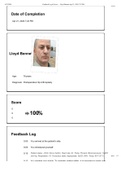
Case Nur 4110 Lloyd Bennett case study : Diagnosis: Postoperative Hip Arthroplasty /Age 76 years
Nur 4110 Lloyd Bennett case study : Diagnosis: Postoperative Hip Arthroplasty /Age 76 years. 1:10 Patient status - ECG: Sinus rhythm. Heart rate: 91. Pulse: Present. Blood pressure: 105/68 mm Hg. Respiration: 17. Conscious state: Appropriate. SpO2: 95%. Temp: 99 F (37 C) 1:26 You identified the patient. To maintain patient safety, it is important that you quickly identify the patient. 1:34 You asked if the patient was allergic to anything. He replied: 'No, I am not allergic to anythin...
- Case
- • 5 pages •
Nur 4110 Lloyd Bennett case study : Diagnosis: Postoperative Hip Arthroplasty /Age 76 years. 1:10 Patient status - ECG: Sinus rhythm. Heart rate: 91. Pulse: Present. Blood pressure: 105/68 mm Hg. Respiration: 17. Conscious state: Appropriate. SpO2: 95%. Temp: 99 F (37 C) 1:26 You identified the patient. To maintain patient safety, it is important that you quickly identify the patient. 1:34 You asked if the patient was allergic to anything. He replied: 'No, I am not allergic to anythin...
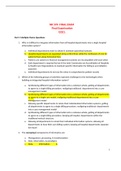
NR 599 Final Exam / NR599 Final Exam (Latest 2021): Chamberlain College Of Nursing (ANSWERS VERIFIED ALL CORRECT)
NR 599- FINAL EXAM Final Examination l2021. Part I: Multiple Choice Questions 1. Why is it difficult to integrate information from all hospital departments into a single hospital information system? a. Individual departments want to obtain & maintain specialized systems b. Hospital departments are organized along vertical lines while the continuum of care for patients flows along horizontal lines c. Patient care systems & financial management systems are incompatible with each other d....
- Exam (elaborations)
- • 15 pages •
NR 599- FINAL EXAM Final Examination l2021. Part I: Multiple Choice Questions 1. Why is it difficult to integrate information from all hospital departments into a single hospital information system? a. Individual departments want to obtain & maintain specialized systems b. Hospital departments are organized along vertical lines while the continuum of care for patients flows along horizontal lines c. Patient care systems & financial management systems are incompatible with each other d....

NURS 6512 MIDTERM Exam / NURS 6512N Midterm Exam: 100% Correct Answers, Download To Score A
• NUR 6512N MIDTERM EXAM GRADE SCORE A+ Question 1 1 out of 1 points To perform the Rinne test, place the tuning fork on the: Selected mastoid Answer: bone. • Question 2 1 out of 1 points Mr. Johnson presents with a freely movable cystic mass in the midline of the high neck region at the base of the tongue. This is most likely a: Selected D. thyroglossal duct Answer: cyst. • Question 3 1 out of 1 points Nuchal rigidity is most commonly associated with: Select...
- Exam (elaborations)
- • 20 pages •
• NUR 6512N MIDTERM EXAM GRADE SCORE A+ Question 1 1 out of 1 points To perform the Rinne test, place the tuning fork on the: Selected mastoid Answer: bone. • Question 2 1 out of 1 points Mr. Johnson presents with a freely movable cystic mass in the midline of the high neck region at the base of the tongue. This is most likely a: Selected D. thyroglossal duct Answer: cyst. • Question 3 1 out of 1 points Nuchal rigidity is most commonly associated with: Select...
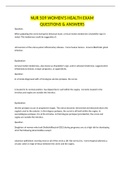
Exam (elaborations) NR-603 Week 1 Quiz (100% Correct)
Question: Which of the following are potential causes of delirium in the elderly? Mark all that apply. Question: Personality changes in patients with Traumatic Brain Injury include all of the following except: Question: Common presenting symptoms of dementia include all of the following except: Question: Which type of medication may be particularly dangerous when treating aggression in patients with traumatic brain injury (TBI) because it could cause paradoxical agitation? Question: Chris is a 2...
- Exam (elaborations)
- • 25 pages •
Question: Which of the following are potential causes of delirium in the elderly? Mark all that apply. Question: Personality changes in patients with Traumatic Brain Injury include all of the following except: Question: Common presenting symptoms of dementia include all of the following except: Question: Which type of medication may be particularly dangerous when treating aggression in patients with traumatic brain injury (TBI) because it could cause paradoxical agitation? Question: Chris is a 2...

Exam (elaborations) NR 509 Women’s Health Exam Questions & Answers
NUR 509 WOMEN’S HEALTH EXAM QUESTIONS & ANSWERS Question: When palpating the cervix during the bimanual exam, cervical motion tenderness (chandelier sign) is noted. This tenderness could be suggestive of: retroversion of the c inflammatory disease. Correctvulvar lesions. IncorrectBartholin gland infection. Explanation: Cervical motion tenderness, also known as Chandelier's sign, and/or adnexal tenderness, suggest pelvic inflammatory disease, ectopic pregnancy, or appendicitis. Ques...
- Exam (elaborations)
- • 25 pages •
NUR 509 WOMEN’S HEALTH EXAM QUESTIONS & ANSWERS Question: When palpating the cervix during the bimanual exam, cervical motion tenderness (chandelier sign) is noted. This tenderness could be suggestive of: retroversion of the c inflammatory disease. Correctvulvar lesions. IncorrectBartholin gland infection. Explanation: Cervical motion tenderness, also known as Chandelier's sign, and/or adnexal tenderness, suggest pelvic inflammatory disease, ectopic pregnancy, or appendicitis. Ques...
